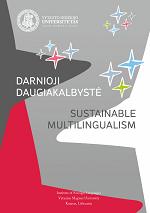Daugiakalbystė LDK: realijos, politika, žaidimai
Multilingualism in the Great Duchy of Lithuania: reality, politics, play on language
Author(s): Sigitas LūžysSubject(s): Cultural Essay, Political Essay, Societal Essay
Published by: Vytauto Didžiojo Universitetas
Keywords: multilingualism; GDL; writings; greetings (gratulationes); multilingualism; notes of friendship; “makaroniko“ style of poetry
Summary/Abstract: The present article analyses the formation of multilingual society in medieval Lithuania. It aims specifically at investigating the origin of multilingualism in the Grand Duchy of Lithuania and its implications on the development of Lithuanian society, political and cultural peculiarity, linguistic diversity as well as the construction of ethnic identity. The Grand Duchy of Lithuania, a nationally and linguistically diverse, multireligious state, had to turn to multilingualism for internal and external communication. Firstly, multilingualism was encouraged by the aspiration to integrate the state of Lithuania into the Europe of those days in the cultural, economic and political sense (even in the pre-Christian period). Multilingualism flourished exceptionally in the internal communication of the Grand Duchy of Lithuania: at least six languages were used for the purposes of script and literature alone. The same number of languages was used in everyday communication among different ethnic groups. In the 16th century, the strengthening of linguistic policy manifestations enabled the formation of at least four cultural information dissemination codes that survived until the 19th century. All of them were based on signification of a different language as the aspect of cultural development. As the study revealed, the origin of Lithuanian multilingualism can be associated with both the geopolitical situation of the ancient Lithuania and internal political framework of a multinational state. Cultural, religious and political processes determined a specific situation of communication in the country which manifested itself by almost parallel use of several languages in societal life. Languages exerted impact upon the formation of four different cultural information dissemination codes, discerning the models of Lithuanian, Latin (Roman), Byelorussian and Polish or Sarmatian culture. Politicization of language performed in 1697, when on the basis of the law of Coequation (Coaequatio iurium) the Polish language was entrenched in state offices, indicated essential changes in the state language policy: the Polish language became one among the equal languages of the GDL . Still the multinationality and diversity of confessions were maintained in cultural communication, literature, religion and science. Multilingualism disappeared from the state offices to emerge in public paratheatre events and was firmly anchored in creativity for special occasions and sophisticated poetry where it was mainly expressed by multilingual greetings of sovereigns and the noble. The conclusion is drawn in the study that Lithuanian multilingualism, closely related with societal multiculturalism and development of ethnic identity as well as religious tolerance of the ancient state, outlived the Grand Duchy of Lithuania: a new political situation in the 19th century failed to impose monolingualism both to private and partly to public life.
Journal: Darnioji daugiakalbystė
- Issue Year: 2012
- Issue No: 1
- Page Range: 31-42
- Page Count: 12
- Language: Lithuanian

